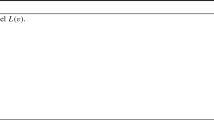Abstract
We consider space efficient hash tables that can grow and shrink dynamically and are always highly space efficient, i.e., their space consumption is always close to the lower bound even while growing and when taking into account storage that is only needed temporarily. None of the traditionally used hash tables have this property. We show how known approaches like linear probing and bucket cuckoo hashing can be adapted to this scenario by subdividing them into many subtables or using virtual memory overcommitting. However, these rather straightforward solutions suffer from slow amortized insertion times due to frequent reallocation in small increments. Our main result is Dynamic Space Efficient Cuckoo Table (DySECT ) which avoids these problems. DySECT consists of many subtables which grow by doubling their size. The resulting inhomogeneity in subtable sizes is counterbalanced by the flexibility available in bucket cuckoo hashing where each element can go to several buckets each of which containing several cells. Experiments indicate that DySECT works well with loads up to 98%. With up to 1.9 times better performance than the next best solution. Additionally, we give a tight theoretical analysis for the possible load threshold of DySECT, i.e., a bound where with high probability the table can be filled up to that load but not above said load. This load also matches our experimental findings.









Similar content being viewed by others
Notes
We change notation slightly. In [17] X and Y were called A and B, the operator \(\min \) was denoted by \(\wedge \), \(n_{\mathsf {max}}^*\) was simply M and m was n.
Experiments on a desktop machine and a server with Intel Xeon E5-2670 CPUs yielded similar results.
References
Aldous, D., Michael Steele, J.: The Objective Method: Probabilistic Combinatorial Optimization and Local Weak Convergence, pp. 1–72. Springer, Berlin (2004)
Arbitman, Y., Naor, M., Segev, G.: De-amortized cuckoo hashing: provable worst-case performance and experimental results. In: 36th International Conference on Automata, Languages and Programming (ICALP), number 5555 in LNCS, pp. 107–118. Springer (2009)
Celis, P., Larson, P.-A., Ian Munro, J: Robin hood hashing. In: 26th IEEE Symposium on Foundations of Computer Science (FOCS), pp. 281–288 (1985)
Devroye, L., Morin, P.: Cuckoo hashing: further analysis. Inf. Process. Lett. 86(4), 215–219 (2003)
Dietzfelbinger, M., Goerdt, A., Mitzenmacher, M., Montanari, A., Pagh, R., Rink, M.: Tight thresholds for cuckoo hashing via XORSAT. In: 27th International Conference on Automata, Languages and Programming (ICALP), pp. 213–225 (2010)
Dietzfelbinger, M., Karlin, A., Mehlhorn, K., Meyer auf der Heide, F., Rohnert, H., Tarjan, R.E.: Dynamic perfect hashing: upper and lower bounds. SIAM J. Comput. 23(4), 738–761 (1994)
Dietzfelbinger, M., Mitzenmacher, M., Rink, M.: Cuckoo hashing with pages. In: 19th European Symposium on Algorithms (ESA), number 6942 in LNCS, pp. 615–627. Springer (2011)
Dietzfelbinger, M., Weidling, C.: Balanced allocation and dictionaries with tightly packed constant size bins. In: International Colloquium on Automata, Languages, and Programming, pp. 166–178. Springer (2005)
Dietzfelbinger, M., Weidling, C.: Balanced allocation and dictionaries with tightly packed constant size bins. Theor. Comput. Sci. 380(1), 47–68 (2007)
Fotakis, D., Pagh, R., Sanders, P., Spirakis, P.: Space efficient hash tables with worst case constant access time. Theory Comput. Syst. 38(2), 229–248 (2005)
Fountoulakis, N., Panagiotou, K., Steger, A.: On the insertion time of cuckoo hashing. SIAM J. Comput. 42(6), 2156–2181 (2013)
Frieze, A., Melsted, P., Mitzenmacher, M.: An analysis of random-walk cuckoo hashing. SIAM J. Comput. 40(2), 291–308 (2011)
Guibas, L.J., Szemeredi, E.: The analysis of double hashing. J. Comput. Syst. Sci. 16(2), 226–274 (1978)
Kirsch, A., Mitzenmacher, M.: Less hashing, same performance: Building a better bloom filter. In 14th European Symposium on Algorithms (ESA), number 4168 in LNCS, pp. 456–467. Springer (2006)
Kirsch, A., Mitzenmacher, M.: Using a queue to de-amortize cuckoo hashing in hardware. In: 45th Annual Allerton Conference on Communication, Control, and Computing, vol. 75 (2007)
Knuth, D.E.: The Art of Computer Programming Sorting and Searching, vol. 3. Addison Wesley Longman Publishing Co., Inc., Boston (1998)
Lelarge, M.: A new approach to the orientation of random hypergraphs. In: Proc. 23rd SODA, pp. 251–264 (2012)
Li, X., Andersen, D.G., Kaminsky, M., Freedman, M.J.: Algorithmic improvements for fast concurrent cuckoo hashing. In: 9th European Conference on Computer Systems, EuroSys, pp. 27:1–27:14. ACM (2014)
Maier, T., Sanders, P.: Dynamic space efficient hashing. In: 25th Annual European Symposium on Algorithms (ESA 2017), vol. 87 of Leibniz International Proceedings in Informatics (LIPIcs). Schloss Dagstuhl–Leibniz-Zentrum fuer Informatik (2017)
Mitzenmacher, M.: The power of two choices in randomized load balancing. IEEE Trans Parallel Distrib. Syst. 12(10), 1094–1104 (2001)
Mitzenmacher, M.: Some open questions related to cuckoo hashing. In: 17th European Symposium on Algorithms (ESA), Vol. 5757 of LNCS, pp. 1–10. Springer (2009)
Mitzenmacher, M., Panagiotou, K., Walzer, S.: Load thresholds for cuckoo hashing with double hashing. In: 16th Scandinavian Symposium and Workshops on Algorithm Theory (SWAT 2018), volume 101 of Leibniz International Proceedings in Informatics (LIPIcs), pp. 29:1–29:9. Schloss Dagstuhl–Leibniz-Zentrum fuer Informatik (2018)
Nguyen, N., Tsigas, P.: Lock-free cuckoo hashing. In: 34th IEEE International Conference on Distributed Computing Systems (ICDCS), pp. 627–636 (2014)
Pagh, R., Rodler, F.F.: Cuckoo hashing. J. Algorithms 51(2), 122–144 (2004)
Walzer, S.: Load thresholds for cuckoo hashing with overlapping blocks. CoRR, abs/1707.06855 (2017)
Author information
Authors and Affiliations
Corresponding author
Additional information
Publisher's Note
Springer Nature remains neutral with regard to jurisdictional claims in published maps and institutional affiliations.
Rights and permissions
About this article
Cite this article
Maier, T., Sanders, P. & Walzer, S. Dynamic Space Efficient Hashing. Algorithmica 81, 3162–3185 (2019). https://doi.org/10.1007/s00453-019-00572-x
Received:
Accepted:
Published:
Issue Date:
DOI: https://doi.org/10.1007/s00453-019-00572-x




